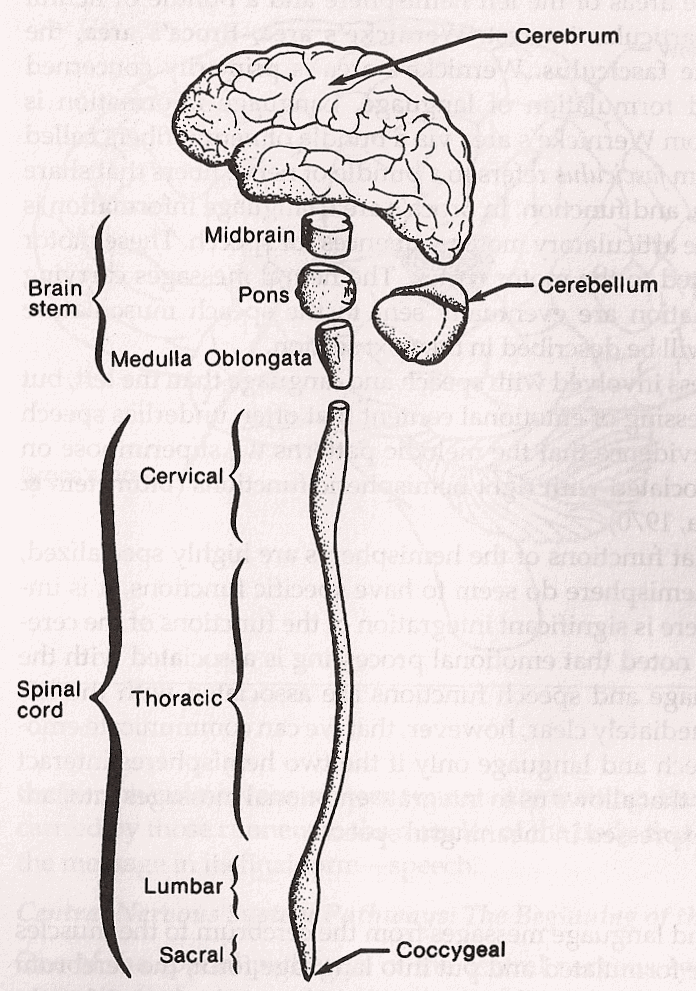- Many nerves connect with one hair cell, and a nerve will connect with more than one hair cell.
Diagram -- a lateral view of the brain stem .
- In this diagram you can see the spinal cord, the medulla, the pons, the midbrain, but not the thalamus, which is the last stop to the cerebral cortex.

- Many nerves connect with the base of the hair cells and then transverse down the core of the cochlea were they emerge in a single bundle (trunk) called the VIII th (Acoustic) nerve.
Connecting nerves never touch but are separated by a gap called a Synapse.
- The word "connect" requires some explanation here. The extensions of the nerves (dendrites and axons) never touch the hair cells or the other nerves in the pathways to and in the brain.
- There is always a tiny gap. And what occurs in this gap is truly amazing. This gap is as wide as the ink on a page of print. In the fluid of the gap are ions of various kinds. This gap, incidentally is called a synapse.
- When the celia of the hair cell is wrenched, an electrical potential in the cell is produced. Molecules (neural transmitters) are emitted from the base of the cell. These cross the gap and embed themselves in special receptacles in the "connecting" nerve.
- After another quick exchange of molecules the membrane of the cell is altered so that ions in the surrounding fluid may enter the cell. When they do, they change the valence of the cell.
The chemistry of the Synapse creates a vital switch which provides inhibition or control of neural pathways.
- The change of valence at the point of entry of the ions creates an electrical gradient (potential) that moves through the cell like a wave. When it reaches the end, the process is repeated for the next connecting neuron. Several things must be noted about this process.
- The specific neural transmitter emitted by a cell determines whether or not ions will enter the next connecting cell.
- This makes the synapse, in essence, a switch which can turn on or off a particular neural pathway. This mechanism is critical to the function of the brain. It provides for inhibition, or the ability to turn off a pathway.
- When these switches fail, electrical storms are free to wander unchecked through the brain wreaking havoc with normal neurological processes. These are called seizures.
Neural function is more a chemical reaction than it is an electrical transmission.
- The synapse, then, is the "guts" of the perceptual processes (to be discussed next), which involve the control and structuring of these neural impulse wave patterns created through transduction.
- The importance and mode of operation of the synapse underscores the role of chemicals in the thought processes; and in my mind the need for good nutrition to keep these processes functioning correctly is worth consideration.
- Although the hair cells can generate electrical potentials that mirror in number the frequency of a sound wave, the connecting nerve cells are relatively limited.
- A nerve cell can fire (replenish its nutrients to create and carry a potential) no more than 1000 per second and then no more than for a second.
- If many cells are involved in such a massive operation, they simply "poop out" and we experience a Temporary Threshold Shift.
The Acoustic Nerves enter the brain stem towards the top of the Medulla where most nerves cross to the opposite side.
- In order that neural transmissions can mirror high frequency sounds, neurons work in complicated units or banks and fire in volleys.
- The Acoustic (VIII th) nerve from each ear enters the brain stem at the level of the top of the Medulla. Here, curiously, most of the nerve fibers cross to the opposite side and proceed up through the Pons, Midbrain and Thalamus to the Temporal Lobe of the Cerebral Cortex.
The Lateral Lemniscus carries the input and the Reticular formation alerts the Cerebrum that it is coming.
- These neural pathways which carry this auditory input up the sides of the brainstem are called the Lateral Lemniscus. There is one more wrinkle in the process of hearing, however.
- There is another neural network which is located in the core of the brain stem, called the Reticular Formation. This network does many things, and one of them is to alert the Cerbral Cortex when information is incoming from the transducer.
- If the Cerebral Cortex is not alerted, the information will still arrive but it will not be processed. The end result will be that we will not hear the sounds that have been transduced.
- I suspect this alerting mechanism is important to the perceptual process also in triggering the brain to prepare for the input. We will discuss this next in the topic on Perception.
- None of this, however, by itself will result in understanding of what is being experienced. At this level it is just noise-- with little use and less asthetic value. It takes a massive amount of work (processing) by the Central Nervous System to create out of this noise meaningful messages. Let's see how that is done through the process of Perception next.
- If all this was jargon, click on the notes below for a more simplified version.